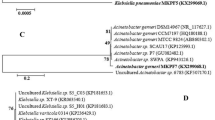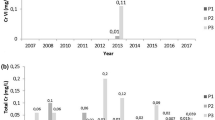Abstract
Cr(III) is indissoluble and shows less toxicity against Cr(VI). Therefore, it is very important to reduce Cr(VI) to Cr(III) by appropriate methods. In the current study, reduction studies of Cr(VI) to Cr(III) by bioremediation method were performed, which is an economical, efficient, and environmentally friendly method. For this, 13 chromium resistant bacteria were obtained from leather industry wastewater of the Gerede-Bolu region of Turkey. As a Cr(VI) source, solutions containing K2Cr2O7 and CrO3 at different concentrations (25–500 mg/L) were prepared separately in nutrient broth, and their minimum inhibitory concentrations (MIC) were determined. BCA13 isolate, which was molecularly identified by 16S rDNA analysis, has the highest MIC value (500 mg/L). The reduction impact of BCA13 isolate in Cr(VI) at different pH conditions (4.0–10.0) was detected. The optimum pH condition was pH 6.5. It was observed that at pH 6.5, BCA13 isolate completely reduced 50, 100, 150, 200, and 250 mg/L Cr(VI), at 32nd, 56th, 64th, 80th, and 96th h, respectively. BCA13 strain could be used in biodegradation studies because it has the ability to reduce at high chromium concentrations.




Similar content being viewed by others
Data Availability
The data sets used and/or analyzed during the current study are available from the corresponding author on reasonable request.
References
Ahmad, W. A., Venil, C. K., Chirwa, E. M. N., Wang, Y. T., Sani, M. H., Samad, A. F. A., Kamaroddin, M. F. A., Donati, E. R. D., Urbieta, M. S., & Zakaria, Z. A. (2021). Bacterial reduction of Cr(VI): Operational challenges and feasibility. Current Pollution Reports, 7, 115–127. https://doi.org/10.1007/s40726-021-00174-8
APHA (American Public Health Association). (2005). Standard methods for the examination of water and wastewater (twenty-first ed.).
Bharagava, R. N., & Mishra, S. (2018). Hexavalent chromium reduction potential of Cellulosimicrobium sp. isolated from common effluent treatment plant of tannery industries. Ecotoxicology and Environmental Safety, 147, 102–109. https://doi.org/10.1016/j.ecoenv.2017.08.040
Chen, J., & Tian, Y. (2021). Hexavalent chromium reducing bacteria: Mechanism of reduction and characteristics. Environmental Science and Pollution Research, 28, 20981–20997. https://doi.org/10.1007/s11356-021-13325-7
Chen, L., Zhang, J., Zhu, Y., & Zhang, Y. (2018). Interaction of chromium(III) or chromium(VI) with catalase and its effect on the structure and function of catalase: An in vitro study. Food Chemistry, 244, 378–385. https://doi.org/10.1016/j.foodchem.2017.10.062
dos Santos, H. R. M., Argolo, C. S., Argolo-Filho, R. C., & Loguercio, L. L. A. (2019). 16S rDNA PCR-based theoretical to actual delta approach on culturable mock communities revealed severe losses of diversity information. BMC Microbiology, 19, 74. https://doi.org/10.1186/s12866-019-1446-2
Elangovan, R., Abhipsa, S., Rohit, B., Ligy, P., & Chandraraj, K. (2006). Reduction of Cr(VI) by a Bacillus sp.,. Biotechnology Letters, 28(4), 247–252. https://doi.org/10.1007/s10529-005-5526-z
Hossan, S., Hossain, S., Islam, M. R., Kabir, M. R., Ali, S., Islam, M. S., Imran, K. M., Moniruzzaman, M., Mou, T. J., Parvez, A. K., & Mahmud, Z. H. (2020). Bioremediation of hexavalent chromium by chromium resistant bacteria reduces phytotoxicity. International Journal of Environmental Research and Public Health, 17, 6013. https://doi.org/10.3390/ijerph17176013
Kafilzadeh, F., & Saberifard, S. (2016). Isolation and Identification of chromium (VI) resistant bacteria from Soltan Abad river sediments (Shiraz-Iran). Jundishapur Journal of Health Sciences, 8(1), 41–47. https://doi.org/10.17795/jjhs-33576
Kalsoom, A., Batool, R., & Jamil, N. (2021). Highly Cr(VI)-tolerant Staphylococcus simulans assisting chromate evacuation from tannery effluent. Green Processing and Synthesis, 10, 295–308. https://doi.org/10.1515/gps-2021-0027
Kathiravan, M. N., Karthick, R., & Muthukumar, K. (2011). Ex situ bioremediation of Cr(VI) contaminated soil by Bacillus sp.: Batch and continuous studies. Chemical Engineering Journal, 169, 107–115. https://doi.org/10.1016/j.cej.2011.02.060
Kumari, V., Yadav, A., Haq, I., Kumar, S., Bharagava, R. N., Singh, S. K., & Raj, A. (2016). Genotoxicity evaluation of tannery effluent treated with newly isolated hexavalent chromium reducing Bacillus cereus. Journal of Environmental Management, 183, 204–211. https://doi.org/10.1016/j.jenvman.2016.08.017
Ma, S., Song, C. S., Chen, Y., Wang, F., & Chen, H. L. (2018). Hematite enhances the removal of Cr(VI) by Bacillus subtilis BSn5 from aquatic environment. Chemosphere, 208, 579–585. https://doi.org/10.1016/j.chemosphere.2018.06.037
Mohammed, M. S. M., El-Arabi, N. I., El-Hussein, A., El-Maaty, S. A., & Abdelhadi, A. A. (2020). Reduction of chromium-VI by chromium-resistant Escherichia coli FACU: A prospective bacterium for bioremediation. Folia Microbiologica, 65, 687–696. https://doi.org/10.1007/s12223-020-00771-y
Oves, M., Khan, M. S., & Zaidi, A. (2013). Chromium reducing and plant growth promoting novel strain Pseudomonas aeruginosa OSG41 enhance chickpea growth in chromium amended soils. European Journal of Soil Biology, 56, 72–83. https://doi.org/10.1016/j.ejsobi.2013.02.002
Pushkar, B., Sevak, P., Parab, S., & Nilkanth, N. (2021). Chromium pollution and its bioremediation mechanisms in bacteria: A review. Journal of Environmental Management, 287, 112279. https://doi.org/10.1016/j.jenvman.2021.112279
Sanjay, M. S., Sudarsanam, D., Ra,j, G. A., & Baskar, K. (2020). Isolation and identification of chromium reducing bacteria from tannery effluent. Journal of King Saud University-Science, 32(1), 265–271. https://doi.org/10.1016/j.jksus.2018.05.001
Sayel, H., Bahafid, W., Joutey, N.T., Derraz, K., Benbrahim, K.F., Koraichi, S.I., Ghachtouli, N.E. (2011). Cr(VI) reduction by Enterococcus gallinarum isolated from tannery waste-contaminated soil. Annals of Microbiology, 1–9. https://doi.org/10.1007/s13213-011-0372-9.
Shekhar, S., Sundaramanickam, A., & Vijayansiva, G. (2014). Detoxification hexavalent chromium by potential chromate reducing bacteria isolated from turnery effluent. American Journal of Research Communication, 2(2), 205–216. ISSN: 2325-4076.
Tan, H., Wang, C., Zeng, G., Luo, Y., Li, H., & Xu, H. (2020). Bioreduction and biosorption of Cr(VI) by a novel Bacillus sp. CRB-B1 strain. Journal of Hazardous Materials, 386, 121628. https://doi.org/10.1016/j.jhazmat.2019.121628
Tarekegn, M. M., Salilih, F. Z., & Ishetu, A. I. (2020). Microbes used as a tool for bioremediation of heavy metal from the environment. Cogent Food & Agriculture, 6(1), 1783174. https://doi.org/10.1080/23311932.2020.1783174
Thatoi, H., Das, S., Mishra, J., Rath, B. P., & Das, N. (2014). Bacterial chromate reductase, a potential enzyme for bioremediation of hexavalent chromium: A review. Journal of Environmental Management, 146, 383–399. https://doi.org/10.1016/j.jenvman.2014.07.014
Wani, P. A., Wani, J. A., & Wahid, S. (2018). Recent advances in the mechanism of detoxification of genotoxic and cytotoxic Cr (VI) by microbes. Journal of Environmental Chemical Engineering, 6, 3798–3807. https://doi.org/10.1016/j.jece.2018.05.042
Xiao, W., Ye, X., Yang, X., Zhu, Z., Sun, C., Zhang, Q., & Xu, P. (2017). Isolation and characterization of chromium (VI)-reducing Bacillus sp. FY1 and Arthrobacter sp. WZ2 and their bioremediation potential. Bioremediation Journal, 21, 100–108. https://doi.org/10.1080/10889868.2017.1282939
Zahoor, A., & Rehman, A. (2009). Isolation of Cr(VI) reducing bacteria from industrial effluent sand their potential use in bioremediation of chromium containing waste water. Journal of Environmental Science, 21, 814–820. https://doi.org/10.1016/s1001-0742(08)62346-3
Acknowledgements
The writers are grateful for the valuable contribution to Dr Mehmet Bahadir ACAR The authors would like to thank Gazi University Academic Writing Application and Research Center (Certificate Number: 28.12.2021/0121).
Funding
This work was supported by the Gazi University Scientific Research Projects Department (05/2015–14 coded project).
Author information
Authors and Affiliations
Contributions
BCA: conceptualization, methodology, investigation, writing—original draft, project administration. ZY: methodology, investigation, resources, funding acquisition, supervision. All authors read and approved the manuscript.
Corresponding author
Ethics declarations
Ethics Approval
This article does not contain any studies with human participants or animals performed by any of the authors.
Consent for Publication
Not applicable.
Competing Interests
The authors declare no competing interests.
Additional information
Publisher's Note
Springer Nature remains neutral with regard to jurisdictional claims in published maps and institutional affiliations.
Highlights
• Minimum inhibitory concentration of Raoultella ornithinolytica BCA13 strain was determined as 500 mg/L. BCA13 strain was able to maintain its viability at high Cr(VI) concentrations. The cell density reached the highest value at the 60th h in all Cr(VI) concentrations.
• Raoultella ornithinolytica BCA13 strain compared to bacteria used in other studies, it was completely reduced at different Cr(VI) concentrations (50, 100, 150, 200, 250 mg/L) in a shorter time. Raoultella ornithinolytica BCA13 strain exhibited high Cr(VI) reduction properties, even at different pH (4.0–10.0) conditions.
• Raoultella ornithinolytica BCA13 strain showed at different conditions and concentrations quite high Cr(VI) reduction capacity. Therefore, it could be used in biodegradation research.
Rights and permissions
Springer Nature or its licensor (e.g. a society or other partner) holds exclusive rights to this article under a publishing agreement with the author(s) or other rightsholder(s); author self-archiving of the accepted manuscript version of this article is solely governed by the terms of such publishing agreement and applicable law.
About this article
Cite this article
Cinar Acar, B., Yuksekdag, Z. Bioreduction of Cr(VI) by Raoultella ornithinolytica BCA13 Obtained from Tannery Effluent. Water Air Soil Pollut 234, 270 (2023). https://doi.org/10.1007/s11270-023-06226-7
Received:
Accepted:
Published:
DOI: https://doi.org/10.1007/s11270-023-06226-7




